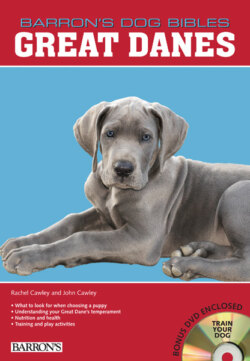Читать книгу Great Danes - Rachel Cawley - Страница 13
На сайте Литреса книга снята с продажи.
The Birth of the Breed
ОглавлениеIt should be stated up front that despite its name, the Great Dane did not originate in Denmark. The Great Dane did not immediately appear as the breed seen today. It was created by blending several existing breeds. And even after the breed had begun to be identified, it took some time before people could settle on a name. England and Germany struggled for years to claim the breed for themselves by attempting to name it after their country.
The Great Dane has been recognized as a breed for more than 400 years. The early Great Danes were called Boarhounds for the job they performed: hunting boars. A boar, being strong and swift, demanded a superior dog to hunt it. Records of the time show these early Great Danes to be quite effective.
As the boar population began to fall, the hounds began a new life. By the sixteenth century the English dubbed the breed English Dogges. These large dogs were bred for image and protection. In the late 1600s a German nobleman bred large numbers of the dogs, prizing the biggest and most attractive. These pampered dogs, often adorned with ornate collars, were kept inside homes and called Kammerhunde, literally meaning “chamber dogs.”
French naturalist Comte de Buffon (1749–1788) gave the breed the name it has today. Buffon authored a massive (more than 35 volumes) natural-history encyclopedia, Historie Naturalle. While visiting Denmark, he came across a sleeker version of the Boarhound. Thinking it a Greyhound, the author said the Danish climate caused the Greyhound to become a Grand Danois, a Great Danish Dog. The name has remained despite attempts to rename the breed.
Fun Facts
Hunting Records
In 1563, more than 2,500 boars were hunted down. The number may be less impressive if one considers the ratio of boars to hounds. One hunter, Duke Henry of Braunschweig, showed up at a hunt in 1592 with 600 male Boarhounds!
